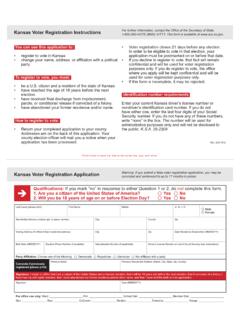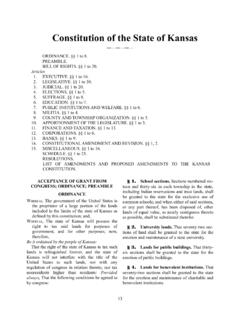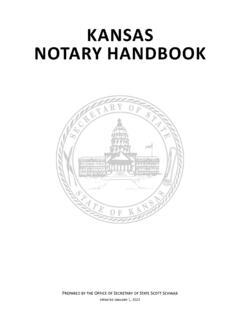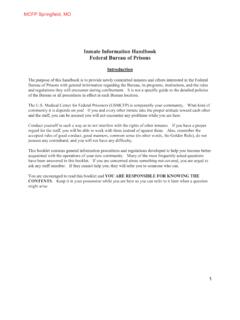Transcription of KANSAS NOTARY PUBLIC HANDBOOK - kssos.org
1 KANSASNOTARY PUBLICHANDBOOKP repared by the Office of Secretary of State Scott SchwabPrepared by the Office of Secretary of StateScott SchwabFirst Floor, Memorial Hall120 SW 10th , KS 66612-1594(785) compliance with the Americans with Disabilities Act, this document is available in alternate formats by contacting the KANSAS Secretary of State, 120 SW 10th Ave., Topeka, KS 66612-1594, (785) 296-4564, Purpose of Notaries PUBLIC 4II. History of Notaries PUBLIC 5 III. Duties of Notaries PUBLIC 6IV. Guidelines for Notaries PUBLIC 8V. Penalties for Improper Notarizations 13VI. Electronic Notarizations 14 VII. Helpful Hints for Notaries PUBLIC 15 VIII. KANSAS Statutes and Regulations 18IX. Frequently Asked Questions 36X. Test your NOTARY Knowledge 44XI. Glossary of Terms 47 XII. Contact Information 50 change of Status Form 51 Table of Contents Title PageKansas NOTARY HandbookThis is an interactive PDF.
2 Click on any chapter title in this table of contents to go to that chapter. Click the running header on any page to return to the table of contents. (Please note that the page numbers of this digital edition differ from the print edition.)4 KANSAS NOTARY HandbookI. Purpose of Notaries PublicAs a NOTARY PUBLIC , you hold an important position in the state of KANSAS . It is essential that you understand the notarial duties and responsibilities given in KANSAS law. The purpose of this HANDBOOK is to help you understand NOTARY laws so that you can perform your duties correctly. The purpose of a NOTARY PUBLIC is to prevent fraud and forgery. The NOTARY acts as an official, unbiased witness to the identity of the per-son who signs the document. A KANSAS NOTARY PUBLIC has six major duties: 1.
3 Take acknowledgments, 2. Administer oaths and affirmations, 3. Take a verification upon oath or affirmation, 4. Witness or attest a signature, 5. Certify or attest a copy, and 6. Note a protest of a negotiable instrument. ( 53-107)5 KANSAS NOTARY HandbookII. History of Notaries PublicThe office of NOTARY PUBLIC had its birth in ancient Roman times when most citizens did not read and write. The NOTARY PUBLIC was a PUBLIC servant, who would act as scrivener and legal advisor to indi-viduals drawing up contracts, deeds and other documents. Because most people could not write and therefore could not sign their name, seals were used to sign and seal the document, evidencing the formal execution and acceptance of the document. Documents executed with the aid of the NOTARY PUBLIC were highly regarded as legitimate and authentic.
4 For hundreds of years, the NOTARY PUBLIC was a PUBLIC officer ap-pointed or elected by high officials. In the United States, notaries were originally appointed by the President. Eventually this control was passed to the states, which often delegate the appointment pro-cess to the secretary of state. The duties of the NOTARY PUBLIC have changed over the years, evolving from legal advisor to ministerial officer; however, the tradition of the NOTARY seal has continued into present day NOTARY HandbookKansas notaries PUBLIC are commissioned by the secretary of state. A commissioned NOTARY may notarize anywhere within the state, but the powers do not extend beyond the borders of the state. Under KANSAS law, a NOTARY PUBLIC can take acknowledgments, ad-minister oaths and affirmations, take verifications, witness or attest a signature, certify a copy, and note a protest of negotiable instru-ments.
5 (A) Acknowledgments: Person appears before the NOTARY and ac-knowledges or declares to the NOTARY that he or she signed the document. (B) Witnessing: Person signs in the presence of the NOTARY PUBLIC . The NOTARY PUBLIC must witness the signature. (C) Verification: Person appears before the NOTARY who administers an oath before he or she signs the document. The signing party signs in the presence of the NOTARY following the oath (see proce-dure below for administering oaths).(D) Administering an Oath/Affirmation: The person raises the right hand or places the right hand on the Bible. The NOTARY ad-ministers the oath, which must begin with the words You do sol-emnly swear and end with the words So help you God. Those opposed to oaths may perform an affirmation, which begins with the words You do solemnly, sincerely, and truly declare and af-firm and ends with the words And this you do under the pains and penalties of perjury.
6 (E) Certifying Copies: The NOTARY certifies that the document is a true and correct copy of the original document. The NOTARY pub-III. Duties of Notaries Public7 KANSAS NOTARY Handbooklic must be presented with the original document and make the copy so as to ensure that the copy is in fact a true copy of the original. This procedure should not be used for publicly recorded documents as the NOTARY PUBLIC cannot obtain the original. Origi-nal documents on file with an office/entity must be certified by that entity ( , court documents are certified by the court clerk who retains the originals; corporation documents filed with the Secretary of State s office are certified by the secretary of state; birth/death certificates are certified by the KANSAS Department of Health and Environment, Office of Vital Statistics, which main-tains the original records, etc.)
7 (F) Noting a Protest: A protest is a certificate of dishonor made by a NOTARY PUBLIC or other person authorized by the law where dishonor occurs. The protest must identify the instrument and certify either that presentment has been made or, if not made, the reason why it was not made, and that the instrument has been dishonored by nonacceptance or nonpayment. The protest also may certify that notice of dishonor has been given to some or all parties. 8 KANSAS NOTARY HandbookPersonal Appearance Required All NOTARY acts require that the person signing the document appear before the NOTARY PUBLIC . Never notarize a document outside the pres-ence of the signing party. A NOTARY is required to properly identify the person to ensure that he or she signed the document; the only way to perform this duty is to have the person appear before the NOTARY .
8 Failure to require a personal appearance by the signing party is the leading cause of NOTARY civil and criminal liability and loss of the NOTARY commission ( 53-503). NOTARY Seal; Signature; Date of Expiration Each NOTARY PUBLIC must have a notarial seal, which shall contain the NOTARY s name exactly as it appears on the NOTARY application. The seal must include the words NOTARY PUBLIC and State of KANSAS . This seal must be used whenever a NOTARY performs an official act. When notarizing a document, the NOTARY PUBLIC must add to the document the date of expiration of his or her appointment. The NOTARY PUBLIC s seal must be either a seal press or a rubber stamp. If a seal press is used, the impression from the seal must be inked or blackened. If a rubber stamp is used, the stamp must have permanent ink.
9 Both the seal press and the rubber stamp must be capable of legible reproduc-tion after copying. No seal can be used until an impression of it has been filed with the Secretary of State s office ( 53-105). Failure to Attach Date of Expiration If the NOTARY PUBLIC willfully neglects or refuses to attach his or her date of expiration of appointment when notarizing a document, the NOTARY PUBLIC shall be deemed guilty of a Class C misdemeanor ( 53-106). Failure to attach the date of expiration also may be grounds for revocation of the NOTARY s appointment ( 53-118). IV. Guidelines for Notaries Public9 KANSAS NOTARY HandbookVerification of Identity When notarizing a document, the NOTARY PUBLIC must exercise rea-sonable care in determining the identity of the person whose signa-ture is being notarized.
10 This is important because the PUBLIC relies on the notarization as proof of the authenticity of the person s signature on the document ( 53-107).Determining the Type of NotarizationThe type of notarization should be evident from the NOTARY block on the document. If the NOTARY block is not already on the document, the signing party or the party drafting/providing the document should instruct the NOTARY PUBLIC what notarial block is required (ac-knowledgment, witnessing or verification). The type of notarization is generally prescribed in the law that governs the document. The NOTARY should not make the determination as to what notarization type is appropriate as this could constitute the unlawful practice of law. However, the NOTARY should know the correct language to be used when the person explains what type of notarization is needed.












